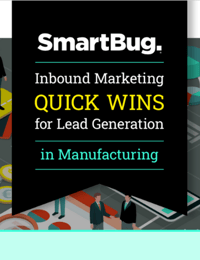
Did you know: Around 96 percent of people who visit your website aren’t actually ready to buy? In today’s digital environment, nurturing leads who visit your manufacturing website is critical. In fact, one of the only ways to encourage those prospects to purchase from your company is to nurture them. In other words, your goal is to equip website visitors with the information they need to solve their problem.
Before we jump into lead nurturing strategies, let’s consider the Buyer's Journey:
The Buyer’s Journey
Photo credit: HubSpot
The awareness stage is when most people become aware of a problem they have, and begin doing research to educate themselves on what exactly the problem is. You might find visitors on your blog or resource pages during this stage. Instead of pushing these people directly to sales, nurturing with relevant top-of-funnel content is usually the way to go.
The consideration stage is when that person has clearly identified their problem—they know what it is and they are dedicated to weighing different approaches that have the potential to solve the problem (i.e., solution aware). Prospects in this stage might be found scrolling through your products and services pages. To nurture these folks, you may also choose to use relevant content, but content that is more specific to a potential solution (e.g., vendor comparisons or case studies) is an even better option.
The decision stage is when the prospect has decided on an approach and is determining which solution they will go with. Prospects in this stage have likely submitted a “contact us” or “demo” form on your website, or engaged with your sales team in some capacity. In this stage, the prospect is considered “provider aware”.
Lead Nurturing Strategies
Although it is important to nurture prospects who have not yet purchased from you, existing customers should also be given that nurturing attention. After all, attracting new customers can be five times more expensive than retaining existing ones.
Here are a few lead nurturing strategies to consider for both prospects and customers:
Re-Engagement Campaign
The goal of running a re-engagement campaign is laid out in the title—to re-engage old leads in your database. If you’re starting to implement a nurturing strategy and you haven’t cleaned up your database recently, doing so is a necessary first step. Make sure all the recipients you’re nurturing are opted in and are expecting to hear from your manufacturing company. If not, those recipients could skew your metrics, giving you an unclear picture of actual performance. By cleaning up your database, you’ll have a more accurate idea of who your subscribers are, which subject lines are catching their attention, and what offers they’re most likely to click.
Special Offer Campaigns
This type of campaign is great for both prospects and current customers. If you know a prospect visited a specific product page, nurture them with an email that offers 10 percent off that product. Encourage them to purchase by a set date in order to receive the offer. Special offer campaigns are also a great way to say “thank you” to current customers. Show existing customers you value their business by offering a larger discount. If you have sales goals around specific products or services, time these emails to align with when you need to close those deals.
Post-Download Campaigns
Is content marketing a part of your manufacturing marketing strategy? Ensure you have lead nurturing campaigns set up to run once a visitor downloads a piece of content. For example, your visitor downloads your “Complete Guide to RFPs.” Three days later, send them a couple of relevant blog articles. A few days after that, send them an RFP Checklist. And a few days after that, send them an email to get in touch with one of your sales reps. Remember, your goal is to be helpful and to provide visitors with relevant information that helps them solve a problem.
Abandoned Cart Campaigns
We’ve all received the “you left this in your cart” email, and for good reason. Nearly 70 percent of shoppers abandon their cart at checkout. What’s even more interesting is that 72 percent will come back to complete their purchase within 12-24 hours. Implementing this type of nurturing is a low-risk, high-yield opportunity. You’ve likely spent time and money nurturing these buyers through their journey, and now they’re at the end of it—ready to make the purchase. If you sell tangible products, set up a series of nurturing emails to encourage buyers to take action, ensuring the first follow up is within that 12- to 24-hour timeframe. This could also come in handy for prospects who requested a proposal but haven’t taken action after receiving it.
Cross-Sell or Upsell Campaigns
One of the most effective ways to nurture your database is by shifting the focus to current customers. Ask yourself, “Is there something more?” If they recently made a purchase from your manufacturing company, are there complementary products or services you can offer? Is there a higher tier product or service that may also provide value? Explore all of the options and nurture existing customers while also generating cross-sell or upsell opportunities for your company.
More Ways to Grow
Whether you’re an original equipment manufacturer or a distributor, the opportunities for nurturing leads are far and wide. Looking for more insight into generating and nurturing leads? Check out our pocket guide, “Inbound Marketing Quick Wins for Lead Generation in Manufacturing.”

About the author
Aubreigh Blair is the SVP, Client Operations for SmartBug. After being introduced to HubSpot in 2014, she began implementing the inbound methodology for both B2B and B2C clients. Aubreigh has experience in a variety of industries including SaaS, financial services, manufacturing, automotive, healthcare, and senior living. Today, she strategizes and implements operational efficiencies to align internal teams, with the ultimate goal of driving revenue growth. Read more articles by Aubreigh Blair.










